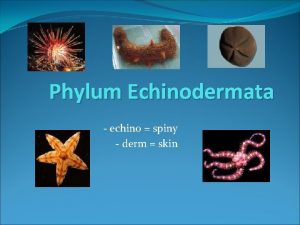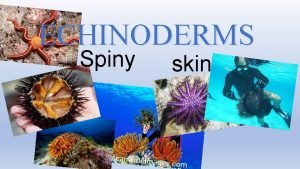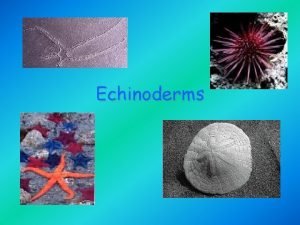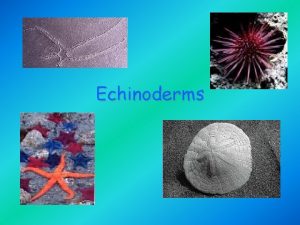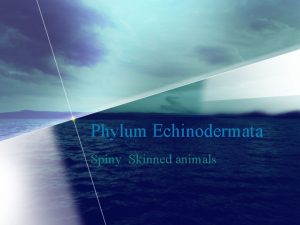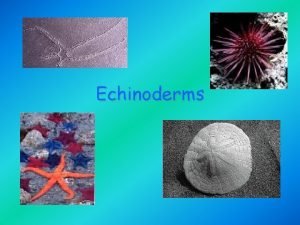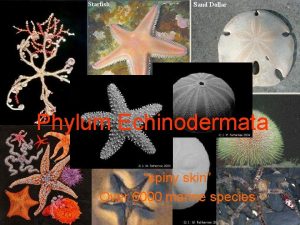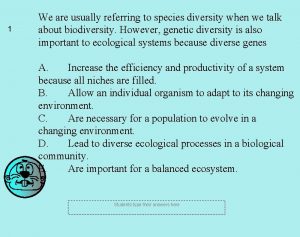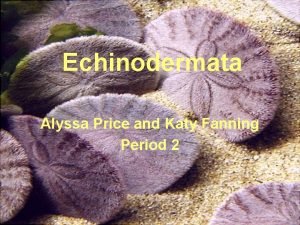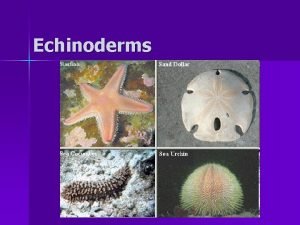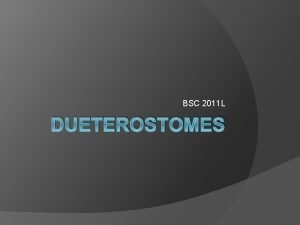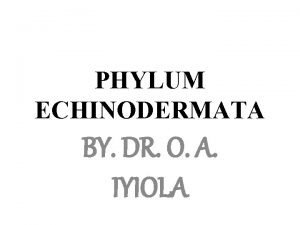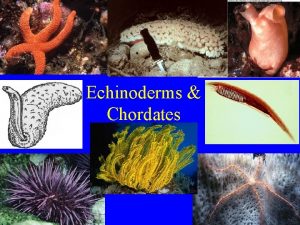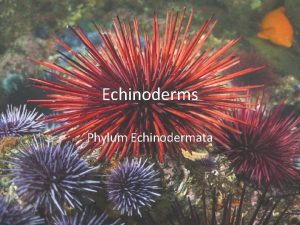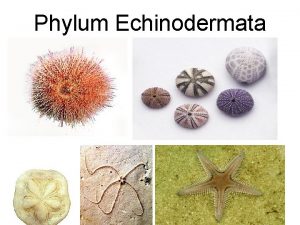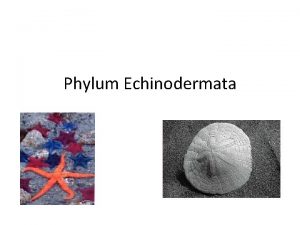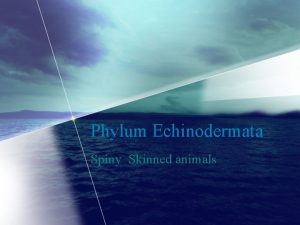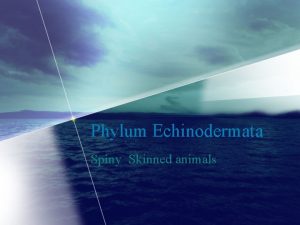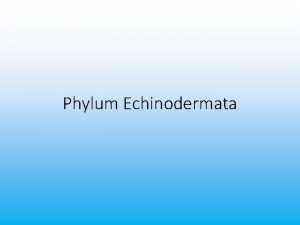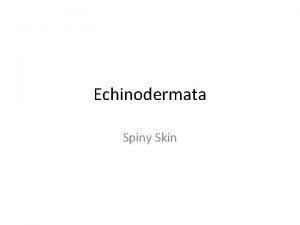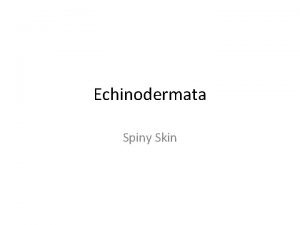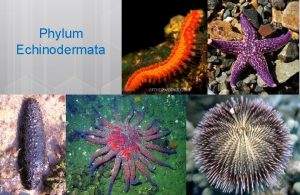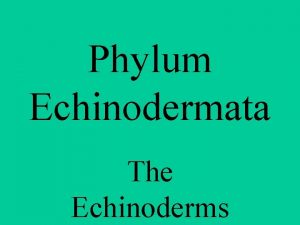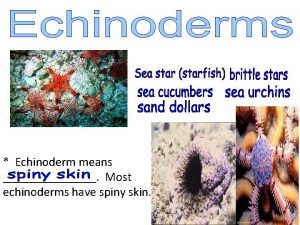Echinoderms Diversity Echinodermata means spiny skin Echinoderms usually


















- Slides: 18

Echinoderms

Diversity Ø Echinodermata means “spiny skin” Ø Echinoderms usually inhabit shallow coastal waters and ocean trenches Ø Organisms in this class include: • Sea stars • Brittle stars • Sand dollars • Sea cucumbers

Characteristics Ø Change from a free-swimming bilaterally symmetrical larva to a bottom-dwelling adult with radial symmetry. Ø Most have five radii or multiples which is known as pentaradial symmetry Ø They have an endoskeleton that is made up of calcium plates, may include protruding spines

Ø Have small feet called tube feet that aid in movement, feeding, respiration, & excretion. Ø Do not have circulatory, respiratory of excretory systems. Ø Have a nervous system but no head or brain. Ø There are two sexes and they can produce sexually and asexually.

Classes Ø Crinoidea Ø Asteroidea Ø Ophiuroidea Ø Echinoidea Ø Holothuroidea

Crinoidea (“lilylike”) Ø They include: Ø Sea lilies Ø Feather stars Ø Crinoidea are sessile: Ø they have long stalks that attach to rocks or to the ocean floor Ø feather stars eventually detach themselves Ø Sticky tube feet that are at the end of each arm catch food and serve as a respiratory surface.

Asteroidea (“star-like”) Ø Starfish or sea stars belong in this class Ø Found all over coastal shores around the world Ø Prey on oysters, clams, and other sea food that is used by people

Ophiuroidea (“snakelike”) Ø Largest echinoderm class Ø Includes basket stars & brittle stars Ø Primarily reside under stones & in crevices and holes of coral reefs Ø Have thin brittle arms that break off & regenerate themselves quickly Ø Feed by raking food off the ocean floor with their arms and bottom of tube feet

Echinoidea (“hedgehoglike”) Ø Sand dollars & sea urchins Ø Test: rigid endoskeleton that the internal organs are compacted in Ø Aristotle’s lantern: complex jaw-like mechanism that is used to grind their food Ø Locomotion: tube feet Ø Protection: barbs on their long spines that are sometimes venomous

Sand dollars Ø Live along seacoasts & sandy areas Ø Flat, round shape bodies; and adaptation for shallow burrowing Ø Locomotion: short spines (also aid in burrowing & cleaning their bodies) Ø Use tubes to filter food out of water

Holothuroidea Ø Sea cucumbers belong in this class Ø Bodies are soft Ø Feeding: tentacles around the mouth sweep up sediment from the water Ø Protection: eject internal organs through the anus. Ø Lost parts are later regenerated Ø Process called evisceration

Structure & Function copyright cmassengale

Body Plan of the Sea Star Ø Oral surface: mouth located on the underside of the body Ø Aboral surface: top of the body Ø Ossicles: sharp protective spines made of calcium plates, covered with thin epidermal layer Ø Pedicellariae: tiny forceps that protect and clean the body surface

Water-Vascular System Ø Hydrostatic pressure permits movement Ø Path of water in the Water-Vascular System u enters sieve plate (through madreporite) u Enters ring canal (encircles mouth) u. Enders 5 radial canals that extend to each arm

Ø Ampulla: bulblike sac that each foot connects to Ø Feet contract, water enters and are able to suction onto surface of slippery rocks

Feeding & Digestion Ø Use feet to attach Ø Eat mollusks, worms, and slow-moving animals Ø Pushes stomach out of body through mouth Ø Pours out enzymes Ø Enzymes help digest food Ø Pulls stomach and digested food back in

Other Body Parts Ø Fluid in coelom bathes organs & distributes nutrients & oxygen Ø Skin gills: protect coelom lining; gases are exchanged Ø Nerve ring: surrounds mouth & branches off into nerve cords in each arm. Ø Eyespots: on each arm that responds to light Ø Tentacles (arms): responds to touch

Reproduction Each arm produces sperm & egg Occurs externally Bipinnaria: free-swimming larva that a fertilized egg develops into Ø Settles in the bottom and develops into an adult through metamorphosis Ø Reproduce asexually by regenerating lost parts Ø Ø Ø
 Phylum
Phylum Endoskeleton and usually a spiny skin
Endoskeleton and usually a spiny skin Echinoderms spiny skin
Echinoderms spiny skin Echinoderm means spiny skin
Echinoderm means spiny skin Marine animals with spiny skeleton
Marine animals with spiny skeleton Starfish anatomy
Starfish anatomy Phylum echinodermata
Phylum echinodermata Bio means life diversity means
Bio means life diversity means Thick skin and thin skin
Thick skin and thin skin Thin skin vs thick skin
Thin skin vs thick skin Chapter 23 milady pdf
Chapter 23 milady pdf The main reason that there are relatively few invertebrates
The main reason that there are relatively few invertebrates Why is genetic diversity important
Why is genetic diversity important Ecosystem jigsaw activity
Ecosystem jigsaw activity Germ layers of echinodermata
Germ layers of echinodermata Echinoderms facts
Echinoderms facts Dueterostomes
Dueterostomes Holothuroidea
Holothuroidea Phylum echinodermata respiratory system
Phylum echinodermata respiratory system
